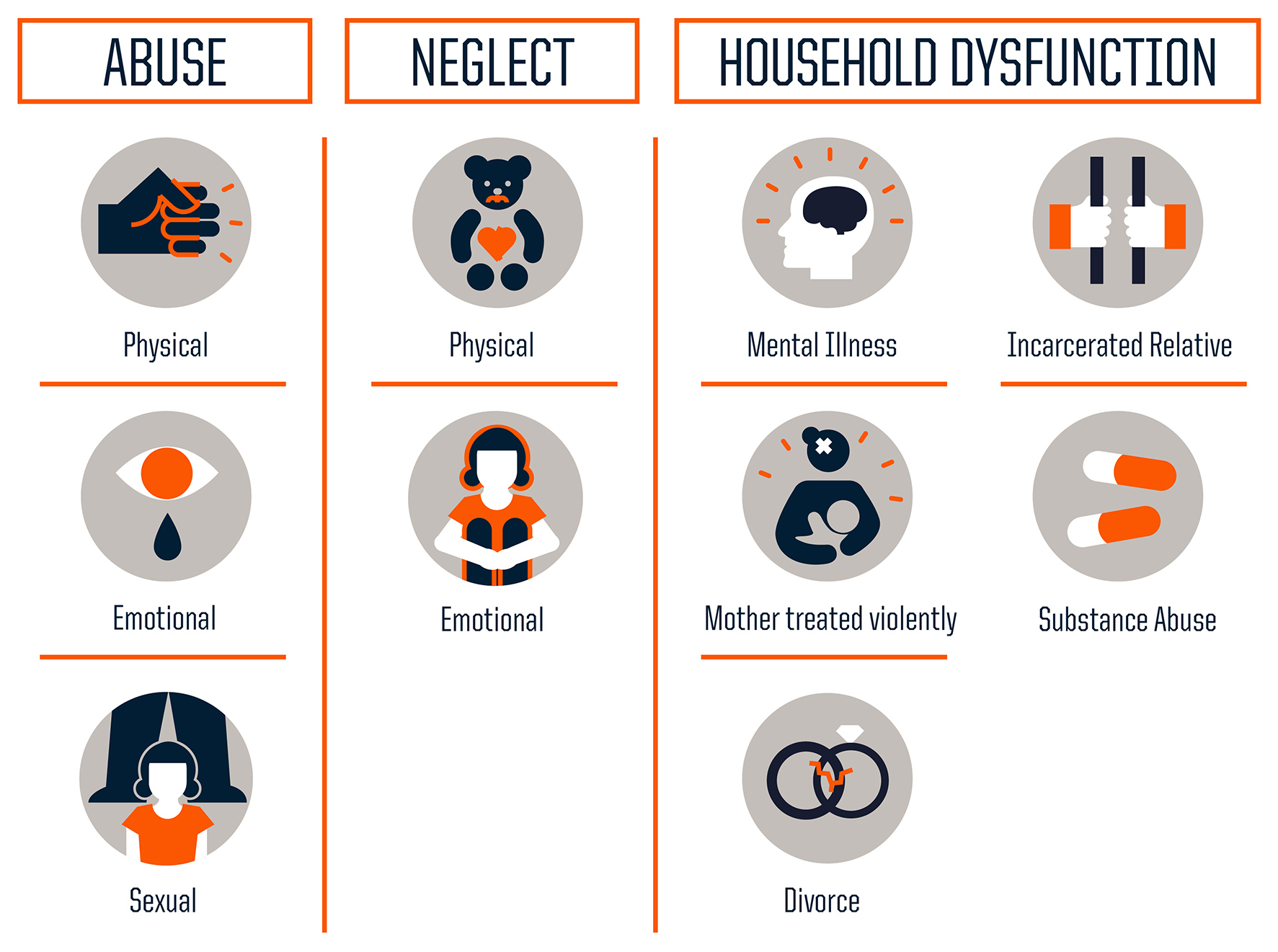Anorexia: Sociocultural explanations
Sociocultural etiologies of anorexia
The sociocultural approach looks at the role of environmental factors in the onset of anorexia. This is a more holistic approach to understanding the disorder. Sociocultural researchers look at the role of protective and risk factors - in what is called a vulnerability model. In addition, the role of social cognitive theory will be explored.
Before completing the module below, please read the section of the textbook called the sociocultural approach to anorexia. When reading this section, please make note of the following important concepts:
- Adverse childhood experiences [ACEs]
- Globalization
- Risk vs protective factors
- Social cognitive theory
- Vulnerability models
The role of environmental factors
Please watch the following video with Nadine Burke Harris. You may have already seen this video if you are also studying the health option. If so, watch it again as a refresher of the concept of Adverse Childhood Experiences [ACEs].
When you have finished, read through the study by Felitti et al (1998) that Burke Harris discusses in the video.

Thinking critically
Try to answer the following questions on your own without looking at the answers. The answers provided are a way to check your own thinking and learning.
1. What would be the difficulty of applying Burke Harris's plan to give an ACE's inventory to all children coming in for treatment?
There are several potential difficulties. First, as she mentions in the video, a multi-disciplinary team is needed. If a child indicates that there is domestic violence at home or that they are being abused, then social services must assist to address the issue. The physician may know what is happening, but may not have any ability to change it. Another problem is that when a child goes to see a doctor, the parents are in the room. This may mean that children do not feel comfortable sharing such information - either because they are scared of losing their parents or fear of punishment. It may also be that child may be too young to read the questionnaire. Oral presentation of the questions may result in demand characteristics - or the questions may be framed as leading questions resulting in false or exaggerated information from the child.
2. Some have argued that Felitti's original 10 ACE's are culturally or class-biased. What are some examples of Adverse Childhood Experiences that may have been left off the list?
There is no mention of growing up in an unsafe neighborhood - for example, witnessing a crime or feeling threatened in your community (e.g. bullying or criminal gangs). In addition, there is nothing about a refugee's experience - for example, losing one's home, having to flee one's country, or having a parent arrested for political beliefs. Finally, there is nothing about "disasters" - for example, losing your home in a fire or hurricane.
3. Another criticism of using such a list with patients is that it doesn't take into account protective factors. What is meant by this statement?
It means that the data collected does not look at potential factors that could actually prevent high levels of stress, in spite of the adverse experience. These might include having a supportive family, a close friend, a stable financial situation, a good diet, or access to health care or counseling.
Linking ACEs to anorexia
Guillaume et al (2016) 102 female patients with anorexia nervosa as defined by the DSM-V were recruited in an outpatient eating disorders unit. All participants were asked to fill in the Childhood Trauma Questionnaire. The study found that childhood abuse was associated with greater severity of the key symptoms of eating disorders, such as food restriction, weight, shape and food concerns, and daily functioning.
Kong and Bernstein (2009) carried out a similar study using a sample of 73 Korean women who had been previously diagnosed with eating disorders: anorexia, bulimia, or binge eating disorder. They were asked to fill in the Childhood Trauma Questionnaire. The researchers found that emotional abuse, physical neglect, and sexual abuse were significant predictors of eating disorders.
Thinking about causality
Why the nature vs nurture debate is over
When I was studying psychology, the big debate was always whether behaviour was because of one's "nature" (genetic or other physical causes) or one's "nurture" (environmental and learned behaviour). Today, psychologists no longer have this debate. It is now understood that biological and environmental factors work together to produce behaviour.
Much of mental illness is an example of "domino causality." In simple linear causality, one thing directly makes another thing happen and the effects end there. But it is very common for effects to become causes of new events.
 What is domino causality?
What is domino causality?
- A sequential unfolding of effects over time
- An extended linear pattern that results in direct and indirect effects
- Typically has a clear beginning and a clear ending
- Can be branching where there is more than one effect of a cause (and these may go on to have multiple effects and so on.)
- Branching forms can be traced back to "stem" causes
- Allows researchers to predicted anticipated outcomes and find multiple potential places to intervene in order to prevent a negative outcome.
So, the question is - what is the link between Burke Harris and Guillaume et al (2016)? How is that someone who has experienced ACEs as a child will go on to develop anorexia as an adult? At this point, we are not really sure what the link is, but we can assume that it must have something to do with gene expression.
Social cognitive theory
One of the big questions about eating disorders is - does the media (film, social media) potentially lead to eating disorders? Read through the following presentation and then answer the questions below.
Critically thinking about research
Answer each of the following questions about the research in the presentation above. Try to answer the question in your notebook or in a separate document before checking your answers below.
1. Explain what is meant by the term vicarious reinforcement.
Vicarious reinforcement is when you learn by watching someone else be rewarded for their behaviour, instead of having to experience the reward yourself. With regard to eating disorders, it is argued that people see the success and fame that thin, beautiful people have in life and this reinforces the idea that it is important to be thin and beautiful to be successful.
2. What was the research method used in Becker et al's study of girls in Fiji? What are the strengths and limitations of this method?
It was a natural experiment. It used a pre-test/post-test design where the girls were tested before television was introduced to their community and then a number of years later. The strength of this method is that it is naturalistic, meaning that it has high ecological validity. One limitation is that natural experiments have low internal validity as the researcher is not able to control for variables. Natural experiments may also be highly influenced by participant variables in the community that is being studied, making it difficult to generalize. Finally, natural experiments often cannot be replicated, lowering the chance of determining the reliability of the findings.
3. Why do researchers carry out meta-analyses?
A meta-analysis is a statistical analysis of several studies with a similar aim and procedure. The reason this is done is to increase sample size and to determine the effect size - that is, the strength of the relationship between variables in a population.
4. What does Groesz et al's (2002) research tell us about the link between media and anorexia?
They found that media had the most significant effect on participants who already had poor body image. The study did not investigate disordered eating, so we cannot know whether this increase in body dissatisfaction would eventually lead to anorexia.
5. What does Tucci and Peter's (2008) research tell us about the link between media and anorexia?
This study did study disordered eating. Although they had similar results to Groesz et al - that is, that thin media increased body dissatisfaction, they did not find that this led to disordered eating behaviours.
6. What was the research method used in Tucci and Peter's research on teen magazine and disordered eating?
This was a true experiment, using a repeated measures design.
7. What does Dittmar et al's (2006) research tell us about the link between Barbie dolls and anorexia?
Girls who saw the Barbie showed more body dissatisfaction than controls or those that saw dolls with normal body shapes. However, this was a cross-sectional study, so we do not know what the long-term effect of this exposure is and whether it is only apparent immediately after seeing the Barbie. There is no evidence of disordered eating behaviour in the study.
8. What was the research method used in Dittmar et al's (2006) research on the effect of Barbie dolls on body image?
This was a true experiment, using an independent samples design.
9. What does Wilksch et al's (2019) research tell us about the link between social media and anorexia?
Both males and females that engaged in high levels of social media usage were more likely to show disordered eating behaviours and judge themselves to be heavier than they actually are.
10. What is the limitation of using a correlational study to determine the link between social media usage and disordered eating?
Correlational studies have the problem of bidirectional ambiguity. In Wilksch's study, we cannot know whether social media usage leads to eating disorders, or whether people with high levels of body dissatisfaction and a predisposition for eating disorders spend more time on social media.
Exam tip
When preparing for the exam, remember that you only need two pieces of research to answer any question on Paper 2. You did not need to prepare both Adverse Childhood Experiences and Social Cognitive Theory. You may prepare one or the other. And in spite of all the interesting studies you see above for the SCT, remember that you only need two. Choose the two that you feel that you understand the best and that you can evaluate with the widest range of comments.
Checking for understanding
You have been asked to write an essay that would evaluate the sociocultural approach to the explanation of one disorder. For each of the following evaluation points, explain what it means with regard to theory or research in the sociocultural approach.
The sociocultural approach takes a more holistic approach to explaining anorexia nervosa than other approaches.
Much of the research done in the sociocultural approach has high ecological validity, but this can also be problematic.
In the sociocultural approach, there are some problems with construct validity.
Cross-cultural research is problematic in explaining the origins of anorexia nervosa.
Sociocultural theories tend to be descriptive rather than explanatory in nature.
Continue to Research methods and ethics

 IB Docs (2) Team
IB Docs (2) Team

